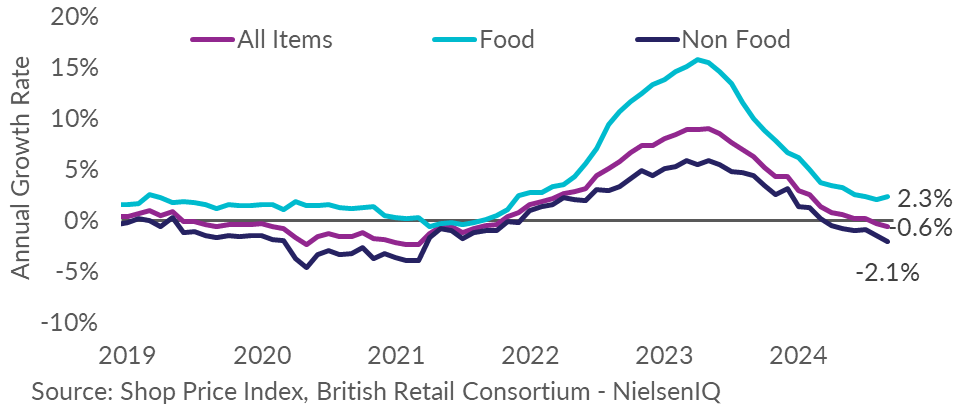BRC-NIELSENIQ SHOP PRICE INDEX – September 2024
Period Covered:
01 – 07 September
2024
- Shop Price deflation was at 0.6% in September, down from
deflation of 0.3% in the previous month. This is below the
3-month average rate of -0.3%. Shop price annual growth was at
its lowest rate since August 2021.
- Non-Food remained in deflation at -2.1% in September, further
down from -1.5% in the preceding month. This is below the 3-month
average rate of -1.5%. Inflation is at its lowest rate since
March 2021.
- Food inflation picked up to 2.3% in September, up from 2.0%
in August. This is above the 3-month average rate of 2.2%. The
annual rate continues to ease in this category and inflation
remained at its lowest rate since November 2021.
- Fresh Food inflation accelerated in September, to 1.5%, up
from 1.0% in August. This is above the 3-month average rate of
1.3%. Inflation returned to its June 2024 rate.
- Ambient Food inflation decelerated to 3.3% in September, down
from 3.4% in August. This is below the 3-month average rate of
3.4% and remained at its lowest since March 2022.
|
|
Overall SPI
|
Food
|
Non-Food
|
|
% Change
|
On last year
|
On last month
|
On last year
|
On last month
|
On last year
|
On last month
|
|
Sep-24
|
-0.6
|
-0.2
|
2.3
|
0.2
|
-2.1
|
-0.5
|
|
Aug-24
|
-0.3
|
0.0
|
2.0
|
0.2
|
-1.5
|
-0.1
|
Note: Month-on-month % change refers to changes in the
level of prices.

Helen Dickinson OBE, Chief Executive of the BRC,
said:
“September was a good month for bargain hunters as big discounts
and fierce competition pushed shop prices further into deflation.
Shop Price inflation is now at its lowest level in over three
years, with monthly prices dropping in seven of the last nine
months. This was driven by non-food, with Furniture and Clothing
showing the biggest drops in inflation as retailers tried to
entice shoppers back. Food inflation edged up slightly as poor
harvests in key producing regions led to higher prices for
cooking oils and sugary products.
“Easing price inflation will certainly be welcomed by consumers,
but ongoing geopolitical tensions, climate change, and
government-imposed regulatory costs could all reverse this trend.
Retail faces a disproportionate tax burden compared to other
industries and Government must take decisive action in the
upcoming Budget and introduce a 20% Retail Rates Corrector - a
20% adjustment to bills for all retail properties - to level the
playing field. This will allow retailers to continue to
offer the best possible prices to their customers while opening
shops, protecting jobs and unlocking investment.”
Mike Watkins, Head of Retailer and Business Insight,
NielsenIQ, said:
“With non-food prices in deflation,
this will help shoppers as they plan their household budgets for
the rest of the year, and the slight increase in food inflation
is indicative of shop price inflation stabilising closer to the
long-term range. Even so, retailers will still need to focus on
driving demand with attractive promotions over the next few
weeks.”
